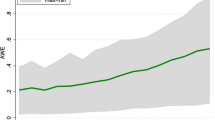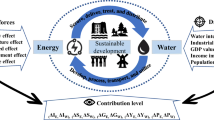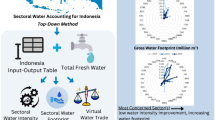Abstract
Water is an essential component of agriculture-food production. As the biomass and biofuel are known excellent sources of renewable and sustainable energy, cultivating process consumes significant quantities of water. Without sufficient, good-quality and easily accessible water, the European agriculture-food production could thus be under threat. This research analyses the impact of the water supply on the bioenergy production in the 28 European Union countries, for the 1990–2018 period within the pathway of the European Union 2030 agenda for sustainable development. The findings using the generalised least squares (GLS) technique show that bioenergy production and population density appear to decrease water supply. Precisely, the magnitude of the effects is − 0.224 and − 0.136 for developing countries and developed countries in the EU, respectively. This indicates that a serious reduction of water security is more likely to happen in developed countries than in developing countries as a result of the increase in bioenergy consumption. In the meantime, fossil fuel, income generation activities and institutional quality have already positively affected water supply. Thus, these findings implied that water scarcity is becoming one of the main obstacles for bioenergy expansion and growth. The results were also further verified by the random effect and pooled oriented least squares method. This study recommends that the Member of the European Union States should continue to increase bioenergy production in the energy mix efforts without any strenuous water security issues. Notwithstanding, there are several situations where a developing bioenergy industry is unlikely to be constrained by water shortage, and with the drive of bioenergy demand, the efforts might unlock new opportunities to adapt to water-related challenges and to improve water usage efficiencies. The authorities should illustrate organised water security and sustainable bioenergy policy by way of developing alternative strategies in reducing fossil fuel power and related CO2 emissions, accordingly to the unique characteristics of both developed and developing countries in the EU.

Similar content being viewed by others
Data availability
Data is available upon request.
References
Abideen Z, Ansari R, Khan MA (2011) Halophytes: potential source of ligno-cellulosic biomass for ethanol production. Biomass Bioenergy 35(2011):1818–1822
Alsaleh M, Abdul-Rahim AS, Mohd-Shahwahid HO (2017a) An empirical and forecasting analysis of the bioenergy market in the EU28 region: evidence from a panel data simultaneous equation model. Renew Sust Energ Rev 80(2017):1123–1137. https://doi.org/10.1016/j.rser.2017.05.167
Alsaleh M, Abdul-Rahim AS, Mohd-Shahwahid HO (2017b) Determinants of technical efficiency in the bioenergy industry in the EU28 region. Renew Sust Energ Rev 78(2017):1331–1349. https://doi.org/10.1016/j.rser.2017.04.049
Alsaleh M, Abdul-Rahim AS, Mohd-Shahwahid HO (2018) Determinants of cost efficiency of bioenergy industry: evidence from EU28 countries. Renew Energy 128C(2018):746–762. https://doi.org/10.1016/j.renene.2018.04.085
Astaiza-Gomez GJ (2020) Lagrange multiplier tests in applied research. J Ciencia Ingeniería 12(2020):13–19
Babatunde RO, Martinetti EC (2010) Impact of remittances on food security and nutrition in rural Nigeria. Unpublished manuscript submitted to. Italy: Center for International Cooperation and Development, University of Pavia
Bah MM, Abdulwakil MM, Azam M (2019) Income heterogeneity and the environmental kuznets curve hypothesis in Sub-Saharan African countries. GeoJournal:1–12
Berndes G (2002) Bioenergy and water -the implications of large-scale bioenergy production for water use and supply. Glob Environ Chang 12(2002):7–25
Berndes G (2008) Water demand for global bioenergy production: trends, risks and opportunities. Report commissioned by the German Advisory Council on Global Change. Berlin, Germany
Berndes G, Fredriksson F, Börjesson P (2004) Cadmium accumulation and Salix based phytoextraction on arable land in Sweden. Agric Ecosyst Environ 103(2004):207–223
Beyene F, Muche M (2010) Determinants of food security among rural households of Central Ethiopia: an empirical analysis. Q J Int Agric 49(4):299–318
Bezuneh M, Yiheyis Z (2014) Has trade liberalization improved food availability in developing countries? An empirical analysis. J Econ Dev 39(2014):63–78
Börjesson P, Berndes G (2006) The prospects for willow plantations for wastewater treatment in Sweden. Biomass Bioenergy 30(2006):428–438
Bruce EH (2016) Econometrics. University of Wisconsin press
Cacho O, Greiner R, Fulloon L (2001) All economic analysis of farm forestry as a means of controlling dryland salinity. Aust J Agric Resour Econ 45(2001):233–256
Canqui BH, Lal R (2009) Crop residue removal impacts on soil productivity and environmental quality. Crit Rev Plant Sci 28(2009):139–163
Cardinael R, Thevathasan N, Gordon A, Clinch R, Mohammed I, Sidders D (2012) Growing woody biomass for bioenergy in a tree-based intercropping system in southern Ontario, Canada. Agrofor Syst 86(2012):279–286
Chiu Y, Walseth B, Suh S (2009) Water embodied in bio-ethanol in the United States. Environ Sci Technol 43(2009):2688–2692
De Fraiture C, Berndes G (2009) Biofuels and water. In: RW Howarth and S Bringezu (eds) Biofuels: environmental consequences & implications of changing land use. pp 139–152
De Fraiture C, Giordano M, Liao Y (2008) Biofuels and implications for agricultural water use: blue impacts of green energy. Water Policy 10(2008):67–81
Dimitriou I, Rosenqvist H (2011) Sewage sludge and wastewater fertilisation of short rotation coppice (SRC) for increased bioenergy production - biological and economic potential. Biomass Bioenergy 35(2011):835–842
Dithmer J, Abdulai A (2017) Does trade openness contribute to food security? A dynamic panel analysis. Food Policy 69(2017):218–230
Emara N, Jhonsa E (2014) Governance and economic growth: the case of Middle Eastern and North African countries. J Dev Econ Policies 16(2014):47–71
Ethan YC, Wi S (2018) Informing regional water-energy-food nexus with system analysis and interactive visualization – a case study in the Great Ruaha River of Tanzania. Agric Water Manag 196(2018):75–86
Feng M, Liu P, Li Z, Zhang J, Liu D, Xiong L (2016) Modeling the nexus across water supply, power generation and environment systems using the system dynamics approach: Hehuang Region, China. J Hydrol 543(2016):344–359. https://doi.org/10.1016/j.jhydrol.2016.10.011
Food and Agriculture Organization of the United Nations (FAO) (2014) The water energy food nexus. A new approach in support of food security and sustainability. pp 4-19
Food and Agriculture Organization of the United Nations (FAO) (2016) The State of Food Insecurity in the World 2015. Meeting the 2015 international hunger targets: taking stock of uneven progress. FAO, Rome.
Garg K, Karlberg L, Wani S, Berndes G (2011) Biofuel production on wastelands in India: opportunities and trade-offs for soil and water management at the watershed scale. Biofuels Bioprod Biorefin 5(2001):410–430
Gaspari M, Lorenzoni A (2018) The governance for distributed energy resources in the Italian electricity market: A driver for innovation?. Renew Sust Energ Rev 82(2018):3623–3632. https://doi.org/10.1016/j.arser.2017.10.100
Gerbens-Leenes PW, Hoekstra AY (2012) The water footprint of sweeteners and bio-ethanol. Environ Int 40(2012):202–211
Gerbens-Leenes PW, Hoekstra AY, Van der Meer TH (2009a) The Water footprint of bioenergy and other primary energy carriers. Ecol Econ 68(2009):1052–1060
Gerbens-Leenes W, Hoekstra AY, Van der Meer TH (2009b) The water footprint of bioenergy. Proc Natl Acad Sci U S A 106(2009):10219–10223
Gleick PH (1994) Water and energy. Annu Rev Energy Environ 19(1994):267–299
Headey D (2013) Developmental drivers of nutritional change: a cross-country analysis. World Dev 42(2013):76–88
Hill J (2006) Economic and energetic costs and benefits of biodiesel and ethanol biofuels. Proc Natl Acad Sci 103(2006):11206–11209
Huang D, Li G, Sun C, Liu Q (2020) Exploring interactions in the local water-energy-food nexus (WEF-Nexus) using a simultaneous equations model. Sci Total Environ 730(2020):135034. https://doi.org/10.1016/j.scitotenv.2019.135034
Jewitt GPW, Wen HW, Kunz RP, Van Rooyen AM (2009) Scoping study on water use of crops/trees for biofuels in South Africa. Report to the water research commission. School of bioresources Engineering and environmental hydrology, University of KwaZulu-Natal, Pietermaritzburg, South Africa
Kaddoura S, Khatib ES (2017) Review of water-energy-food nexus tools to improve the nexus modelling approach for integrated policy making. Environ Sci Pol 77(2017):114–121
Kennedy G, Berardo A, Papavero C, Horjus P, Ballard T, Dop M, Brouwer ID (2010) Proxy measures of household food consumption for food security assessment and surveillance: comparison of the household dietary diversity and food consumption scores. Public Health Nutr 13(12):2010–2018
Kmenta J (1988) Elements of econometrics (MacMillan, New York). Am J Agric Econ 70(1988):210–211. https://doi.org/10.2307/1242003
Kurt S (2016) Short guides to microeconometrics, panel data, fixed and random effects. Available: https://0x9.me/YRDk8
Liu D, Guo S, Liu P, Xiong L, Zou H, Tian J, Zeng Y, Shen Y, Zhang J (2019) Optimisation of water-energy nexus based on its diagram in cascade reservoir system. J Hydrol 569(2019):347–358
Matyas L, Sevestre P (2008) The econometrics of panel data: fundamentals and recent developments in theory and practice. Springer, Berlin, Heidelberg. https://doi.org/10.1007/978-3-540-75892-1
Molden D, Frenken K, Barker R, Fraiture DC, Mati B, Svendsen M, Sadoff C, Finlayson MC (2007) Trends in water and agricultural development. In Molden, D. (ed) Water for food, water for life: a comprehensive assessment of water management in agriculture. London: Earthscan, and Colombo: International Water Management Institute. Accessed at http://www.iwmi.cgiar.org/Assessment/
Moreira J, Peres F (2007) Health, environment and pesticide use in a farming area in Rio de Janeiro state, Brazil. Saude Publica, Rio de Janeiro. Cadernos de Saúde Pública 23(2007):612–621
Neary D, Koestner KA (2012) Forest bioenergy feedstock harvesting effects on water supply. WIREs Energy Environ 1(2012):270–284. https://doi.org/10.1002/wene.26
Nwakuya MT, Ijomah MA (2017) Fixed effect versus random effects modeling in a panel data analysis; a consideration of economic and political indicators in six African countries. Int J Stat Appl 7(2017):275–279. https://doi.org/10.5923/j.statistics.20170706.01
Ogunniyi AI, Mavrotas G, Olagunju KO, Fadare O, Adedoyin R (2020) Governance quality, remittances and their implications for food and nutrition security in Sub-Saharan Africa. World Dev 127(2020):104752. https://doi.org/10.1016/j.worlddev.2019.104752
Orsal DDK (2008) Comparison of panel cointegration tests. J Quant Tech Econ 3(2008):1–20
Pedroni P (1999) Critical values for cointegration tests in heterogeneous panels with multiple regressors. Oxford Bulletin. Econ Stat 61(1999):653–670. https://doi.org/10.1111/1468-0084.0610s1653
Plumper T, Troeger VE (2007) Efficient estimation of time-invariant and rarely changing variables in finite sample panel analyses with unit fixed effects. Polit Anal 15(2007):124–139
Rio D, Burguillo M (2009) An empirical analysis of the impact of renewable energy deployment on local sustainability. Renew Sust Energ Rev 13(2009):1314–1325. https://doi.org/10.1016/j.rser.2008.08.001
Romero-Lankao P, McPhearson T, Davidson D (2017) The food-energy-water nexus and urban complexity. Nat Clim Chang 7(2017):233–235. https://doi.org/10.1038/nclimate3260
Runge C, Senauer B (2008) How ethanol fuels the food crisis. Foreign Affairs, University of Minnesota, USA
Sanzidur R, Sayedur MR (2013) Energy productivity and efficiency of maize accounting for the choice of growing season and environmental factors: an empirical analysis from Bangladesh. Energy 49(2013):329–336. https://doi.org/10.1016/j.energy.2012.10.042
Shokhrukh-Mirzo J, Marko K, Olli V, Saud A, Ward FA (2016) Managing the water-energy-food nexus: gains and losses from new water development in Amu Darya River Basin. J Hydrol 539(2016):648–661. https://doi.org/10.1016/j.jhydrol.2016.05.071
Simpson TW, Martinelli LA, Sharpley AN, Howarth RW (2009) Impact of ethanol production on nutrient cycles and water quality: the United States and Brazil as case studies. In: Howarth RW, Bringezu S (eds) Biofuels: Environmental Consequences & Implications of Changing Land Use, pp 153–167
Sulaiman C, Abdul-Rahim AS, Mohd-Shahwahid OH, Chin L (2017) Wood fuel consumption, institutional quality, and forest degradation in sub-Saharan Africa: evidence from a dynamic panel framework. Ecol Indic 74(2017):414–419. https://doi.org/10.1016/j.ecolind.2016.11.045
Taghizadeh-Hesary F, Rasoulinezhad E, Yoshino N (2019) Energy and food security: linkages through price volatility. Energy Policy 128(2019):796–806. https://doi.org/10.1016/j.enpol.2018.12.043
United Nations Conference on Trade and Development (UNCTAD) (2009) World Investment Report: transnational corporations, agricultural production and development, pp 96–104
Wan R, Ni M (2020) Sustainable development of energy, water, and environment systems. Environ Sci Pollut Res 27(2020):12839–12841. https://doi.org/10.1007/s11356-020-08279
Wilson SE, Butler DM (2007) A lot more to do: the sensitivity of time series cross-section analyses to simple alternative specifications. Polit Anal 15(2007):101–123
Yao L, Chang Y (2014) Energy security in China: a quantitative analysis and policy implications. Energy Policy 67(2014):595–604
Zhang Y, Fang J, Wang S, Yao H (2020) Energy-water nexus in electricity trade network: A case study of interprovincial electricity trade in China. Appl Energy 257(2020):113685
World Bioenergy Association (WBA) (2019) Global bioenergy statistics report. Stockholm, Sweden. https://worldbioenergy.org/globalbioenergy-statistics
Hoff H (2011) Understanding the Nexus. Background paper for the Bonn 2011 Conference: The Water, Energy and Food Security Nexus. Stockholm Environment Institute, Stockholm.
Engle RF, Granger CWJ (1987) Co-integration and error correction: representation, estimation and testing, Econometrica 55:251–276
Pedroni P (2004) Panel cointegration: asymptotic and finite sample properties of pooled time series tests with an application to the PPP hypothesis. Econ Theory 20(2004) :597–625
Kao C (1999) Spurious regression and residual-based tests for cointegration in panel data. J Econ 90:144
Author information
Authors and Affiliations
Contributions
M.A. (Mohd Alsaleh) gathered the data and estimated the panel cointegration model and the competitive advantage of the external factors on the bioenergy and water security in the EU28 region; A.S.A.-R. (Abdul Samad Abdul-Rahim) presented the EU28’s water security and bioenergy industry and put together all the numerical results; M.M.A. (Mansur Muhammad Abdulwakil) contributed with conclusions and recommendations as well as with the limitations of the study and further research; M.A. conducted the literature review; and A.S.A.-R. was responsible for the overall writing process.
Corresponding author
Ethics declarations
Competing interests
The authors declare that they have no competing interests.
Ethical approval
The authors declare the provided manuscript with the title “ EU 28 Region’s Water Security and the Effect of Bioenergy Industry Sustainability” has not been published before nor submitted to another journal for the consideration of publication.
Consent to participate
The authors declare that the manuscript does not report studies involving human participants, human data, or human tissue.
Consent to publish
The authors declare that the manuscript does not contain any individual person’s data in any form (including any individual details, images or videos).
Additional information
Responsible editor: Nicholas Apergis
Publisher’s note
Springer Nature remains neutral with regard to jurisdictional claims in published maps and institutional affiliations.
Rights and permissions
About this article
Cite this article
Alsaleh, M., Abdul-Rahim, A.S. & Abdulwakil, M.M. EU28 region’s water security and the effect of bioenergy industry sustainability. Environ Sci Pollut Res 28, 9346–9361 (2021). https://doi.org/10.1007/s11356-020-11425-4
Received:
Accepted:
Published:
Issue Date:
DOI: https://doi.org/10.1007/s11356-020-11425-4





